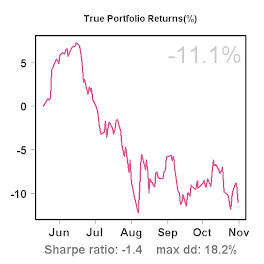Longstoch-ST Per-Trade Statistics
In my previous post on Longstoch-ST I used the daily returns as the unit of observation. In this post I'll switch to the individual trade as the unit of observation. Longstoch-ST has made 70 trades so far, and the graph below shows the percentage P/L (return) per trade (i.e. a position opened for $100, and sold for $110, would show up as 10%). The trades are ordered by the date they were entered. Because the system enters each position with exactly 50% of equity, the account P/L percentage resulting from each trade is half of the P/L per trade.
Two things you'll probably notice immediately is that most of the trades were closed with a profit of 2%, and that there were two trades with large losses (relative to the other trades). Also, more of the recent trades resulted in a loss compared to the older ones.
Despite these losses, the system has a positive expectancy (average return per trade) of 1.17%. I estimated bootstrap confidence intervals at the 95% and 99% level, using both the percentile and BCa method (100,000 replications):
95% Percentile [0.32 , 1.92] ; BCa [0.18 , 1.83]
99% Percentile [0.03 , 2.13] ; BCa [-0.21, 2.00]
Note the large difference between the (simple) Percentile and (advanced) BCa method for the lower bound at the 99% level (0.03 vs -0.21, positive vs negative expectancy).
To get an idea how this first outlier return (-16.9%) affects these results, let's repeat without this trade included:
mean return = 1.44%
95% Percentile [0.80 , 2.05] ; BCa [0.77 , 2.02]
99% Percentile [0.59 , 2.24] ; BCa [0.55 , 2.20]
I think the results including the first trade were pretty good, but this looks even better. The question is: What was going on with this first trade, how likely is it that we'll see this happening in the future, and with what frequency?
It turns out this particular trade was NTAP, entered 7/11/2006 31.41, closed 7/17/2006 26.11. From the chart (below) we can see that the trade was not the result from a sudden overnight gap due to some unexpected earnings news etc. It was bought in a short-term downtrend, which unfortunately did not reverse. As such I put more value on the first set of estimates (including the trade). Because it happened only once so far, there's very little we can say about how often it is expected to occur again.
Tomorrow I'll post some results on drawdowns per trade and discuss how a stop-loss (as the vendor suggests to his subscribers) would have worked out.


No comments:
Post a Comment